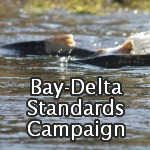In December 2018 the State Water Resources Control Board (State Board) adopted updates to the Bay-Delta Plan (Plan) in accordance with its obligations under the Porter-Cologne Act. The updated Plan included flow objectives intended to restore and protect Chinook salmon and Central Valley steelhead in the lower San Joaquin River and its tributaries.
Twelve lawsuits and 116 claims were filed challenging the State Board’s updated Plan. On March 15, 2024, Sacramento County Superior Court Judge Stephen Acquisto rejected all lawsuits and claims.
To some degree the court’s decision is a win for California’s fisheries, but the decision also affirmed the discretionary right of the State Board to keep less water in rivers than needed to restore fisheries and aquatic ecosystems.
Why the State Board was Sued
The court ruling for this case is 161 pages long and the details of claims made by petitioners are complex. In the most simple terms, protestants filed lawsuits to challenge the flow objectives proposed by the State Board in its 2018 update to the Bay-Delta Plan.
Several water districts including Westlands Water District and Merced Irrigation District filed lawsuits against the State Board arguing that the flow objectives in the 2018 update to the Plan are arbitrary and as such violate the Porter-Cologne Act. The ruling states that petitioners representing municipal and agricultural interests claimed that the flow objectives required “too much water to be released…without leaving enough for agricultural and municipal uses.”
Several environmental groups including San Francisco Baykeeper and the Bay Institute also challenged the State Board’s updated Plan in court. In their view, the prescribed flow objectives for the San Joaquin, Merced, Tuolumne, and Stanislaus Rivers do not go far enough to protect fish.
Bay-Delta Plan Background
California’s Porter-Cologne Act and the federal Clean Water Act require the State Board to create a water quality control plan for the Bay-Delta. The plan must identify beneficial uses of water in the Bay-Delta. The plan must also establish and implement flow objectives to protect those beneficial uses.
The State Board is supposed to review the Bay-Delta Plan every three years. This review includes water quality standards, notably, flow into and out of the Delta. However, the State Board last established flow objectives for the San Joaquin River in its 1995 update to the Bay-Delta Plan. In a 2010 report, the State Board acknowledged that Bay-Delta inflows and outflows are insufficient to support native fish populations.
To address the decline of fish populations the State Board reassessed the Bay-Delta Plan’s flow objectives for the lower San Joaquin River in its 2018 update. The State Board proposed new flow objectives to sustain “inflow conditions from the San Joaquin River watershed to the Delta at Vernalis sufficient to support and maintain the natural production of viable native San Joaquin River watershed fish populations migrating through the Delta.”
The State Board proposed 40% of unimpaired flow with an adaptive range between 30-50% from the Stanislaus, Tuolumne, and Merced rivers from February through June. Unimpaired flow refers to the amount of water that would naturally flow in a river in the absence of dams and diversions. The State Board also proposed that from February through June the flow at Vernalis, the San Joaquin River’s confluence with the Stanislaus River, should be no lower than 1,000 cubic feet per second (cfs).
The Problem with the State Board’s Flow Objectives
Stockton East Water District, a protestant in the lawsuit, claims that the State Board “violated the Porter-Cologne Act by erroneously determining that the LSJR [lower San Joaquin River] flow objectives are necessary to provide protection for the LSJR salmon population.” Stockton East Water District went as far as to claim that there is no substantial evidence on the record that shows a significant decline in the salmon population.
The court denied this claim, stating that “there is abundant scientific evidence in the record showing that decreased flows caused by rim dams and reservoir operations have caused a significant decline in the LSJR [Lower San Joaquin River] salmon population.”
San Francisco Baykeeper claimed that the 40% unimpaired flow objective and 1000 cfs minimum at Vernalis, is insufficient to restore and maintain native fish populations. San Francisco Baykeeper points to multiple scientific studies that show “unimpaired flows of 50% to 60% are the minimum necessary to reestablish and sustain fish and wildlife uses.” California Sportfishing Protection Alliance (CSPA) agrees with this assessment and campaigned for flow objectives consistent with those advocated by SF Baykeeper.
The court also agreed that unimpaired flows of 50% or 60% would better protect native fish in the Lower San Joaquin River. However the court’s ruling determined that the Porter-Cologne Act does not require the State Board to best protect fish, but to reasonably protect fish. The court ruled that 40% unimpaired flow in the Lower San Joaquin River is sufficient to reasonably protect native fish.
How this Ruling Impacts CSPA’s Campaign to Restore Fisheries
To some degree Judge Acquisto’s decision is thus a win for California’s fisheries. The decision upholds the authority of the State Board to limit diversions from the San Joaquin River and its tributaries to protect native fish species. It affirms the use of a percent of unimpaired flow as a reasonable basis for flow objectives (requirements).
However, the decision affirmed the State Board’s discretion to keep flow requirements lower than the flows needed to recover fish and aquatic ecosystems. This part of the decision is extremely concerning, as the State Board now faces proposed “voluntary agreements” that would allow even lower flows throughout the Central Valley. The purpose of the Voluntary Agreements is to replace enforceable protective flows with voluntary and non-flow measures.
CSPA was involved with this lawsuit for some time, but was forced to cease involvement due to procedural matters. CSPA is, however, deeply involved in negotiating better conditions for fish with the State Board as it prepares its next update to the Bay-Delta Plan. CSPA also continues to participate in other legal and regulatory proceedings to secure flows to protect fisheries in the San Joaquin River and its tributaries.









